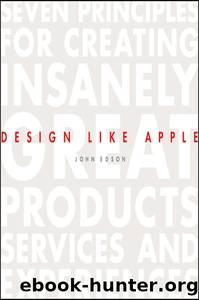John Edson by Design Like Apple

Author:Design Like Apple [Apple, Design Like]
Language: eng
Format: epub
Tags: Business, Design, Non-Fiction, Science, Technology
ISBN: 9781118331767
Amazon: B007ZDN8XQ
Published: 0101-01-01T00:00:00+00:00
While Sony has struggled, Apple started 2012 with its stock at an all-time high. Its market value surged to over $400 billion, bringing it neck and neck with the oil giant Exxon. Apple's cash horde totaled over $100 billion. Of course, it was great products and premium prices that helped swell Apple's bottom line. Yet the foundation of Apple's financial success is also based on its ability to link products to the experience around it and to sell all the other stuff related to that experience. Apple makes money off the product as well as the context that surrounds the product. Instead of churning out dozens of look-alike products for narrowly defined markets, Apple brings out only a few great products and extends the context around them with more products and services in what is euphemistically known as the iUniverse.
That universe never stops expanding. By the first quarter of 2012, Apple had sold more than 25 billion apps from its App Store. More than 16 billion songs had been downloaded from iTunes (a number that CEO Tim Cook gleefully compared to the 220,000 Walkman cassette players that took Sony 30 years to sell). All those beautifully designed Apple products were being sold in more than 300 beautifully designed Apple Stores worldwide. The context and the experience are the ways Apple keeps itself situated directly in front of the customer—in the fabled catbird seat—because the customer not only needs the product but all things related to it.
Creating context is not an idea that originated with Apple, although in my mind it has shrewdly elevated context to a new and lucrative level. In an early iteration of the concept, Eliel Saarinen, the influential twentieth-century modernist architect, put it this way, “Always design a thing by considering it in its next larger context—a chair in a room, a room in a house, a house in an environment, an environment in a city plan.”2 He was describing the way an architect thinks about context when designing a building, as well as the intrinsic, interlocking relationships that exist between the smallest components and the space around it in ever-expanding circles. Apple took that idea, which I call zooming out, and ran with it. Zooming out and away from a problem to see the bigger picture is an activity that takes place in the right brain, the home to most creative thinking. The opposite of that is zooming in, which lets you observe the smallest details of a problem in seeking a solution.
Download
This site does not store any files on its server. We only index and link to content provided by other sites. Please contact the content providers to delete copyright contents if any and email us, we'll remove relevant links or contents immediately.
Wonder by R.J. Palacio(7732)
Unlabel: Selling You Without Selling Out by Marc Ecko(2981)
POP by Steven Heller(2884)
Hidden Persuasion: 33 psychological influence techniques in advertising by Marc Andrews & Matthijs van Leeuwen & Rick van Baaren(2778)
The Pixar Touch by David A. Price(2740)
Ogilvy on Advertising by David Ogilvy(2682)
Drawing Cutting Edge Anatomy by Christopher Hart(2678)
Slugfest by Reed Tucker(2417)
The Art of War Visualized by Jessica Hagy(2412)
The Curated Closet by Anuschka Rees(2385)
Stacked Decks by The Rotenberg Collection(2270)
The Wardrobe Wakeup by Lois Joy Johnson(2235)
365 Days of Wonder by R.J. Palacio(2233)
The Code Book by Simon Singh(2210)
Rapid Viz: A New Method for the Rapid Visualization of Ideas by Kurt Hanks & Larry Belliston(2195)
Tell Me More by Kelly Corrigan(2195)
Keep Going by Austin Kleon(2161)
Tattoo Art by Doralba Picerno(2083)
Tokyo Geek's Guide: Manga, Anime, Gaming, Cosplay, Toys, Idols & More - The Ultimate Guide to Japan's Otaku Culture by Simone Gianni(1947)
